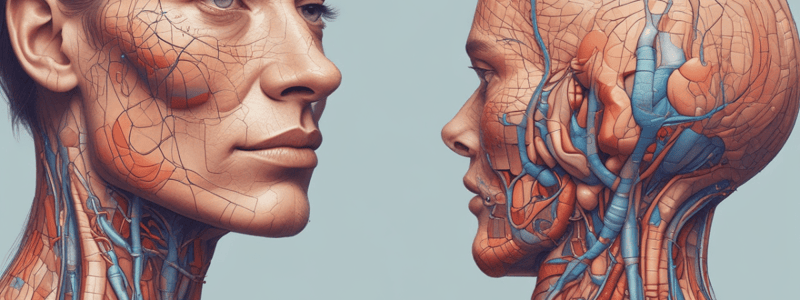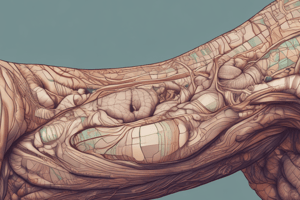Podcast
Questions and Answers
What is the outermost layer of the skin?
What is the outermost layer of the skin?
- Epidermis (correct)
- Mesothelial CT
- Hypodermis
- Dermis
What is the function of melanin in the skin?
What is the function of melanin in the skin?
- To protect against mechanical insults
- To synthesize Vitamin D3
- To regulate body temperature
- To provide UV-protection to cell nuclei (correct)
What is the function of the dermal papillae?
What is the function of the dermal papillae?
- To synthesize Vitamin D3
- To regulate electrolyte balance
- To store excess energy
- To integrate with invading epidermal ridges (correct)
What is the function of the skin in terms of protective functions?
What is the function of the skin in terms of protective functions?
What is the function of sweat in the skin?
What is the function of sweat in the skin?
What is the function of the hypodermis?
What is the function of the hypodermis?
What is the function of mechanoreceptors in the skin?
What is the function of mechanoreceptors in the skin?
What is the function of the dermis?
What is the function of the dermis?
What is the function of the skin in terms of metabolic functions?
What is the function of the skin in terms of metabolic functions?
What is the function of the skin in terms of immune response?
What is the function of the skin in terms of immune response?
What is the main function of melanin in the skin?
What is the main function of melanin in the skin?
What type of sweat glands produce sex pheromones?
What type of sweat glands produce sex pheromones?
Which type of cells are responsible for producing eumelanins in the skin?
Which type of cells are responsible for producing eumelanins in the skin?
What is the primary function of the granular layer in the epidermis?
What is the primary function of the granular layer in the epidermis?
What is the name of the layer of connective tissue that supports the epidermis and binds it to the subcutaneous tissue?
What is the name of the layer of connective tissue that supports the epidermis and binds it to the subcutaneous tissue?
Which of the following is NOT a function of Langerhans cells?
Which of the following is NOT a function of Langerhans cells?
What type of cells are responsible for producing pigment in the epidermis?
What type of cells are responsible for producing pigment in the epidermis?
What is the term for the process by which keratinocytes become filled with amorphous, fibrillar proteins?
What is the term for the process by which keratinocytes become filled with amorphous, fibrillar proteins?
What is the name of the unique patterns formed by the ridges and grooves in the thick skin of palms and soles?
What is the name of the unique patterns formed by the ridges and grooves in the thick skin of palms and soles?
What is the name of the protein that accumulates in keratinocytes to form a supranuclear cap?
What is the name of the protein that accumulates in keratinocytes to form a supranuclear cap?
What type of cells are found in the basal layer of the epidermis?
What type of cells are found in the basal layer of the epidermis?
What is the name of the structure that forms a dense network in the dermis?
What is the name of the structure that forms a dense network in the dermis?
What is the function of the desmosomes in the spinous layer?
What is the function of the desmosomes in the spinous layer?
What is the name of the structures that form in the granular layer as a result of keratinization?
What is the name of the structures that form in the granular layer as a result of keratinization?
What is the term for the process by which the cells become fully keratinized or cornified?
What is the term for the process by which the cells become fully keratinized or cornified?
Which of the following is a function of Merkel cells?
Which of the following is a function of Merkel cells?
What is the function of the lipid-rich layer formed in the granular layer?
What is the function of the lipid-rich layer formed in the granular layer?
What is the name of the layer that separates the dermis from the subcutaneous tissue?
What is the name of the layer that separates the dermis from the subcutaneous tissue?
What is the name of the layer of the epidermis found only in thick skin?
What is the name of the layer of the epidermis found only in thick skin?
What is the primary component of the stratum corneum?
What is the primary component of the stratum corneum?
What is the function of arteriovenous anastomoses/shunts in the skin?
What is the function of arteriovenous anastomoses/shunts in the skin?
What type of sensory receptors are simple nerve endings with no Schwann cells?
What type of sensory receptors are simple nerve endings with no Schwann cells?
Which type of sensory receptors are found in the papillary dermis and extending into the lower epidermal layers?
Which type of sensory receptors are found in the papillary dermis and extending into the lower epidermal layers?
What is the function of Meissner corpuscles?
What is the function of Meissner corpuscles?
What is the structure that surrounds the initial part of the hair root?
What is the structure that surrounds the initial part of the hair root?
What is the phase of hair growth characterized by a long period of mitotic activity and growth?
What is the phase of hair growth characterized by a long period of mitotic activity and growth?
What is the function of the arrector pili muscle?
What is the function of the arrector pili muscle?
What is the structure that separates the hair follicle from the surrounding dermis?
What is the structure that separates the hair follicle from the surrounding dermis?
What is the structure that forms when the distal end of the nail becomes longer and hangs free from the nail bed and epidermal fold?
What is the structure that forms when the distal end of the nail becomes longer and hangs free from the nail bed and epidermal fold?
What is the layer of keratinized cells that covers the cortex of the hair shaft?
What is the layer of keratinized cells that covers the cortex of the hair shaft?
Flashcards are hidden until you start studying
Study Notes
Skin Structure and Functions
- The skin is the largest organ of the body, consisting of three layers: epidermis, dermis, and hypodermis.
- Functions of the skin include:
- Protection: physical barrier, immune response, UV protection, and permeability barrier
- Sensory: contains many types of sensory receptors to monitor the environment and regulate interaction with physical objects
- Metabolic: vitamin D3 synthesis, electrolyte regulation, and energy storage
- Sexual signaling: features like hair and skin pigment serve as visual indicators of health and attraction
- Elasticity: skin can expand rapidly and repairs itself quickly
Epidermis
- The epidermis is the outermost layer of the skin, composed of stratified squamous epithelium
- Consists of multiple layers, with the number of layers varying depending on skin thickness
- Layers of the epidermis:
- Basal layer: single layer of basophilic cuboidal or columnar cells with intense mitotic activity
- Spinous layer: thickest layer, consisting of polyhedral cells with tonofibrils and desmosomes
- Granular layer: three to five layers of flattened cells undergoing keratinization
- Stratum lucidum: thin, translucent layer of flattened eosinophilic keratinocytes (only found in thick skin)
- Stratum corneum: outermost layer, composed of multiple layers of keratinized squamous cells
Melanocytes
- Found in the basal layer of the epidermis and hair follicles
- Produce eumelanins, black and brown pigments
- Melanin synthesis: tyrosinase activity converts tyrosine into DOPA, which is then polymerized into different forms of melanin
- Melanosomes are transported to keratinocytes, which absorb and scatter sunlight, providing UV protection
Dermis
- A layer of connective tissue that supports the epidermis and binds it to the subcutaneous tissue
- Consists of two sublayers:
- Papillary layer: loose connective tissue with type I and III collagen fibers, fibroblasts, and scattered mast cells
- Reticular layer: thicker layer consisting of dense irregular connective tissue with type I collagen fibers and proteoglycans
- Rich in blood and lymphatic vessels, with two main plexuses: subpapillary plexus and dermal plexus
Subcutaneous Tissue/Hypodermis/Superficial Fascia
- Loose connective tissue that binds the skin loosely to organs, making it possible for skin to slide over them
- Contains adipocytes and has an extensive vascular supply, allowing for rapid uptake of drugs and insulin when injected into the tissue
Sensory Receptors
- Uncapsulated receptors: simple nerve endings with no Schwann cells
- Capsulated receptors: covered in collagen and have a more complex structure with sensory fibers enclosed by glia and delicate connective tissue
- Types of sensory receptors include:
- Merkel cells: tonic receptors for sustained light touch and sensing an object's texture
- Free nerve endings: respond to high and low temperatures, pain, and itching
- Root hair plexus: detects hair movement
- Meissner corpuscles: initiate impulses when light touch or low-frequency stimuli are applied to the skin
- Lamellated corpuscles: sense touch, pressure, and vibrations
- Krause end bulbs: sense low-frequency vibrations
- Ruffini corpuscles: stimulated by stretch or twist in skin
Studying That Suits You
Use AI to generate personalized quizzes and flashcards to suit your learning preferences.




